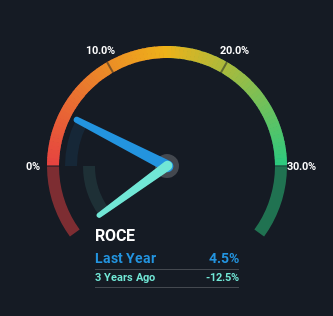Stock Analysis
- United Kingdom
- /
- Oil and Gas
- /
- AIM:TRIN
Returns Are Gaining Momentum At Trinity Exploration & Production (LON:TRIN)

If we want to find a stock that could multiply over the long term, what are the underlying trends we should look for? Amongst other things, we'll want to see two things; firstly, a growing return on capital employed (ROCE) and secondly, an expansion in the company's amount of capital employed. Put simply, these types of businesses are compounding machines, meaning they are continually reinvesting their earnings at ever-higher rates of return. Speaking of which, we noticed some great changes in Trinity Exploration & Production's (LON:TRIN) returns on capital, so let's have a look.
Understanding Return On Capital Employed (ROCE)
For those who don't know, ROCE is a measure of a company's yearly pre-tax profit (its return), relative to the capital employed in the business. The formula for this calculation on Trinity Exploration & Production is:
Return on Capital Employed = Earnings Before Interest and Tax (EBIT) ÷ (Total Assets - Current Liabilities)
0.045 = US$5.1m ÷ (US$127m - US$15m) (Based on the trailing twelve months to June 2023).
Thus, Trinity Exploration & Production has an ROCE of 4.5%. Ultimately, that's a low return and it under-performs the Oil and Gas industry average of 13%.
See our latest analysis for Trinity Exploration & Production

In the above chart we have measured Trinity Exploration & Production's prior ROCE against its prior performance, but the future is arguably more important. If you'd like, you can check out the forecasts from the analysts covering Trinity Exploration & Production for free.
The Trend Of ROCE
Trinity Exploration & Production has broken into the black (profitability) and we're sure it's a sight for sore eyes. While the business was unprofitable in the past, it's now turned things around and is earning 4.5% on its capital. On top of that, what's interesting is that the amount of capital being employed has remained steady, so the business hasn't needed to put any additional money to work to generate these higher returns. So while we're happy that the business is more efficient, just keep in mind that could mean that going forward the business is lacking areas to invest internally for growth. Because in the end, a business can only get so efficient.
The Key Takeaway
To sum it up, Trinity Exploration & Production is collecting higher returns from the same amount of capital, and that's impressive. Given the stock has declined 68% in the last five years, this could be a good investment if the valuation and other metrics are also appealing. That being the case, research into the company's current valuation metrics and future prospects seems fitting.
One more thing, we've spotted 4 warning signs facing Trinity Exploration & Production that you might find interesting.
If you want to search for solid companies with great earnings, check out this free list of companies with good balance sheets and impressive returns on equity.
Valuation is complex, but we're helping make it simple.
Find out whether Trinity Exploration & Production is potentially over or undervalued by checking out our comprehensive analysis, which includes fair value estimates, risks and warnings, dividends, insider transactions and financial health.
View the Free AnalysisHave feedback on this article? Concerned about the content? Get in touch with us directly. Alternatively, email editorial-team (at) simplywallst.com.
This article by Simply Wall St is general in nature. We provide commentary based on historical data and analyst forecasts only using an unbiased methodology and our articles are not intended to be financial advice. It does not constitute a recommendation to buy or sell any stock, and does not take account of your objectives, or your financial situation. We aim to bring you long-term focused analysis driven by fundamental data. Note that our analysis may not factor in the latest price-sensitive company announcements or qualitative material. Simply Wall St has no position in any stocks mentioned.
About AIM:TRIN
Trinity Exploration & Production
Trinity Exploration & Production plc, an independent oil company, engages in the exploration, development, production, and sale of crude oil in Trinidad & Tobago.
Excellent balance sheet with moderate growth potential.

